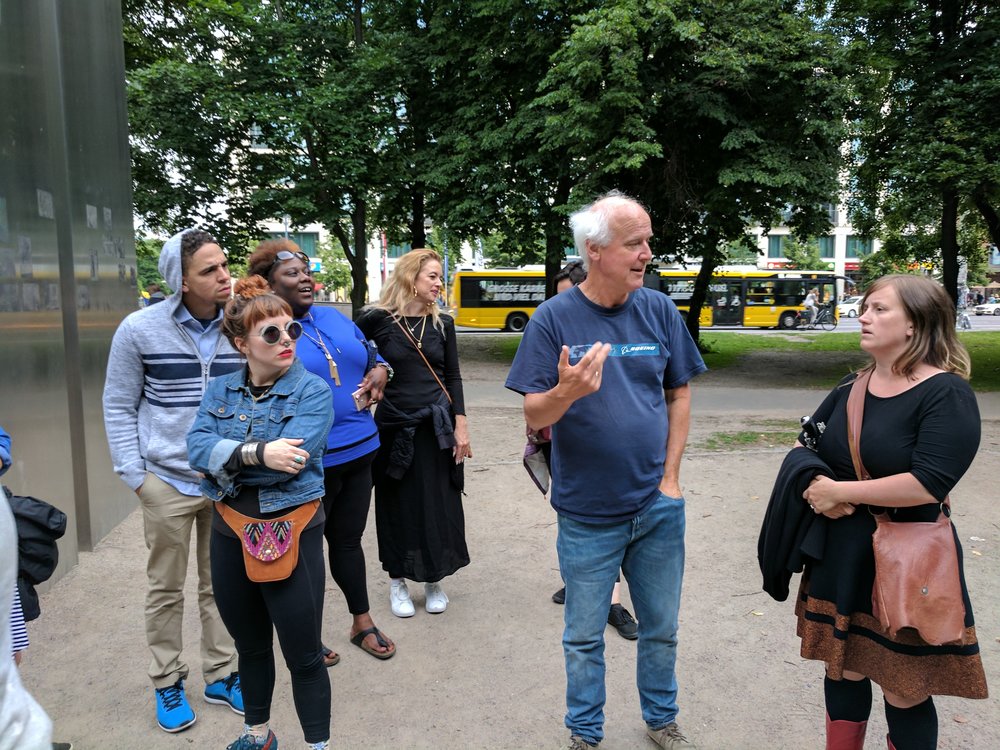Aesthetic Insecurity in Berlin
November 14, 2017
by Katherine Melcher
If you were an artist living in Germany during the rise of Nazism, what would you do? If you could, would you escape? Would you practice a form of hidden resistance – by painting watercolors under the bedsheets, for example? Or would you turn your art into an outward expression of political resistance?

With this question, Howard Caygill, Professor of Philosophy, Aesthetics, and Visual Culture, connected IDSVA’s Berlin seminar to our experiences visiting the city’s monuments, memorials, and museums. With this question, he also shifted our topological experience of German history from one of security – observing the physical remnants of fascism, genocide, World Wars, and the Cold War from the comfortable distance of a tourist – to one of insecurity. For, how can we say what we would do in a situation that we can barely imagine?
A similar shift from certainty to insecurity forms the core of Caygill’s recent philosophical works. He has been exploring how Kant’s three critiques would change if we replaced Kant’s search for secure answers with an approach based on insecurity.

In The Critique of Judgement, Kant defines aesthetic pleasure as finding harmony between one’s imagination and understanding. To provide examples of an aesthetics that does not rely on understanding, Caygill turns to art made by the mentally ill in Europe from the 1880s through the 1950s.
Caygill started his narrative with the Prinzhorn collection, an archive of patients’ work from the University of Heidelberg’s psychiatric hospital from 1890 to 1920. Although originally collected as diagnostic tools; the drawings, paintings, and other works became known to the art world through Hans Prinzhorn’s exhibits and his book Artistry of the Mentally Ill, 1922. By reclassifying these objects as art, Prinzhorn challenged Kant’s assumption that aesthetic judgment relies on reason and consciousness. In these cases, patients were creating art, not through mental reasoning, but through what Prinzhorn called Gestalten (configuring). In the process of making art, the patients were not in a contemplative, mindful reflection; instead, they were moving pieces, scribbling, using their bodies, and following impulses. Caygill points out that Prinzhorn’s interpretation may have expanded our definition of art, but his interpretation remains centered around art as the core aesthetic experience. Perhaps, Caygill suggests, if we can re-center the entire discussion of aesthetics around the work of these patients, we will discover that these works are more than art and, perhaps, that aesthetics is more than art, too.
To re-center our thoughts, Caygill shared another example: Aimable Jayet (1883-1953), a patient at the Saint-Alban Psychiatric Hospital. Although his works were admired by the Art Brut movement, Jean Oury, his psychiatrist, noted that Jayet did not create objects for the aesthetic contemplation of others. Instead, his compulsive writing and drawing was a deeply-personal act of conjuring; as Caygill put it, he was “holding back the end of the world.” Caygill commented, “Calling it art, humiliates the work.”
What are these works, then, if it not art? According to Prinzhorn, they are an act of configuring, creating order. But, in a world where there is no hope of order or where so-called order results in terror, perhaps they are acts of conjuring, turning to magic to hold back the end of the world. Caygill suggests that madness is not a condition removed from life; it is immersed in it. For the mad, life is not edited and ordered by our understanding. Our understanding builds bunkers, erects walls, and creates safe distances. It configures and conjures against the insecurity and madness in life. Through these reflections, Caygill shifted our center of aesthetic inquiry from art to a question of life, to finding ways to be human in an unstable and insecure world.

